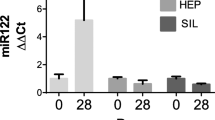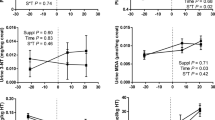Abstract
This study aimed to evaluate the influence of sodium monensin on the hepatic accumulation of copper in sheep. Twenty-four Santa Inês crossbred sheep were used and allocated in a 2 × 2 factorial experiment with six repetitions and considering the factors dietary copper (basal and high) and supplementation (with and without sodium monensin). Thus, four homogeneous groups were formed: control (basal diet); monensin (Mon), 30 ppm of monensin; copper (Cu), 10 10 mg/kg BW per day of copper; monensin + copper (MonCu). The experimental period lasted 14 weeks. Liver and bile samples were collected at the beginning and end of the experiment to determine mineral element concentrations, and weekly blood samples for biochemical, hematological, and mineral evaluation. Liver copper concentrations at the beginning of the experiment did not vary between groups, while mean liver copper concentrations at the end of the experiment were higher in the MonCu, Cu, and Mon groups when compared to the control. At the end of the study, hepatic copper concentration was influenced by copper (p = 0.0001) and monensin (p = 0.0003) supplementation. Copper-supplemented groups had reduced liver iron contents (p = 0.0287) and increased copper concentrations in bile. The biochemical evaluation showed increased serum GGT and AST activity (p < 0.05) in the Cu and MonCu groups from the eleventh week on compared to the control and Mon groups. The increase in activity of these enzymes was influenced by copper supplementation (p = 0.0340). Monensin interferes positively with the hepatic accumulation of copper and the supplementation of this additive may predispose sheep to copper poisoning.

Similar content being viewed by others
Data Availability
All the raw data collected in this research is fully and completely available upon request to the corresponding author.
References
Ramírez-López A, Figueroa-Sandoval B, Figueroa-Rodríguez KA, Ramírez-Valverde B (2020) Structure and concentration of the global sheep meat market. Rev Bras Zootec 49:. https://doi.org/10.37496/RBZ4920190033
Almeida TL, Brum KB, Lemos RAA et al (2013) Doenças de ovinos diagnosticadas no Laboratório de Anatomia Patológica Animal da Universidade Federal de Mato Grosso do Sul (1996–2010). Pesqui Veterinária Bras 33:21–29. https://doi.org/10.1590/S0100-736X2013000100005
Rissi DR, Pierezan F, Oliveira Filho JC et al (2010) Doenças de ovinos da região Central do Rio Grande do Sul: 361 casos. Pesqui Veterinária Bras 30:21–28. https://doi.org/10.1590/S0100-736X2010000100004
Hill GM, Shannon MC (2019) Copper and zinc nutritional issues for agricultural animal production. Biol Trace Elem Res 188:148. https://doi.org/10.1007/S12011-018-1578-5
Shen X, Min X, Zhang S et al (2020) Effect of heavy metal contamination in the environment on antioxidant function in Wumeng semi-fine wool sheep in Southwest China. Biol Trace Elem Res 198:505–514. https://doi.org/10.1007/S12011-020-02081-3
Song CJ, Gan S (2020) Shen X (2020) Effects of nano-copper poisoning on immune and antioxidant function in the Wumeng semi-fine wool sheep. Biol Trace Elem Res 1982(198):515–520. https://doi.org/10.1007/S12011-020-02085-Z
Cousins RJ (1985) Absorption, transport, and hepatic metabolism of copper and zinc: special reference to metallothionein and ceruloplasmin. Physiol Rev 65:238–309. https://doi.org/10.1152/physrev.1985.65.2.238
López-Alonso M, Prieto F, Miranda M et al (2005) Intracellular distribution of copper and zinc in the liver of copper-exposed cattle from northwest Spain. Vet J 170:332–338. https://doi.org/10.1016/j.tvjl.2004.07.007
Minervino AHH, Barrêto Júnior RA, Ferreira RNF et al (2009) Clinical observations of cattle and buffalos with experimentally induced chronic copper poisoning. Res Vet Sci 87:473–478. https://doi.org/10.1016/j.rvsc.2009.05.002
Ortolani EL, Machado CH, Minervino AHH et al (2011) Clinical observations and acid-base imbalances in sheep during chronic copper poisoning. Semin Agrar 32:1123–1132. https://doi.org/10.5433/1679-0359.2011v32n3p1123
Minervino AHH, Barrêto Jr RA, Ferreira RNF et al (2009) Accumulative copper poisoning in buffaloes. Semin Agrar 30:407–416
Howell JM, Gawthorne JM (1987) Copper in animals and man, 1st edn. CRC Press, Boca Raton
Suttle NF (2010) Mineral nutrition of livestock. CABI, Cambridge
Humann-Ziehank E, Coenen M, Ganter M, Bickhardt K (2001) Long-term observation of subclinical chronic copper poisoning in two sheep breeds. J Vet Med Ser A Physiol Pathol Clin Med 48:429–439. https://doi.org/10.1046/j.1439-0442.2001.00376.x
Reis LF, Sousa RS, Oliveira FLC et al (2018) Comparative assessment of probiotics and monensin in the prophylaxis of acute ruminal lactic acidosis in sheep. BMC Vet Res 14:9. https://doi.org/10.1186/s12917-017-1264-4
Araújo JS, Perez JRO, Paiva PCA et al (2006) Efeito da monensina sódica no consumo de alimentos e pH ruminal em ovinos. Arch Vet Sci 11:39–43. https://doi.org/10.5380/AVS.V11I1.5619
Horton GMJ, Stockdale PHG (1981) Lasalocid and monensin in finishing diets for early weaned lambs with naturally occurring coccidiosis. Am J Vet Res 42:433–436
Elsasser TH (1984) Potential interactions of ionophore drugs with divalent cations and their function in the animal body. J Anim Sci 59:845–853. https://doi.org/10.2527/JAS1984.593845X
Starnes SR, Spears JW, Froetschel MA, Croom WJ (1984) Influence of monensin and lasalocid on mineral metabolism and ruminal urease activity in steers. J Nutr 114:518–525. https://doi.org/10.1093/JN/114.3.518
van Ryssen JBJ, Barrowman PR (1987) Effect of ionophores on the accumulation of copper in the livers of sheep. Anim Sci 44:255–261. https://doi.org/10.1017/S0003356100018626
Ivan M, M de S Dayrell M, Hidiroglou M (1992) Effects of bentonite and monensin on selected elements in the stomach and liver of fauna-free and faunated sheep. J Dairy Sci 75:201–208. https://doi.org/10.3168/jds.S0022-0302(92)77754-6
Dehghani SN, Ghadrdani AM (1995) Bovine rumenotomy: comparison of four surgical techniques. Can Vet J 36:693
Minervino AHH, Barrêto Júnior RA, Rodrigues FAML et al (2009) Biópsia hepática por laparotomia paracostal em bovinos e búfalos. Ciência Rural 39:798–802. https://doi.org/10.1590/S0103-84782009000300025
Ortolani EL, Maruta CA, Barrêto Junior RA et al (2020) Metabolic profile of steers subjected to normal feeding, fasting, and re-feeding conditions. Vet Sci 7:95. https://doi.org/10.3390/VETSCI7030095
Minervino AHH, López-Alonso M, BarrêtoJúnior RA et al (2018) Dietary zinc supplementation to prevent chronic copper poisoning in sheep. Animals 8:227. https://doi.org/10.3390/ani8120227
Luna D, Miranda M, Minervino AHH et al (2019) Validation of a simple sample preparation method for multielement analysis of bovine serum. PLoS ONE 14:e0211859. https://doi.org/10.1371/journal.pone.0211859
Radostits OM, Gay CC, Hinchcliff KW, Constable PD (2007) Veterinary medicine: a textbook of the diseases of cattle, sheep, pigs, goats, and horses, 10th edn. Saunders Elsevier, London
Marques AVS, Soares PC, Riet-Correa F et al (2011) Teores séricos e hepáticos de cobre, ferro, molibdênio e zinco em ovinos e caprinos no estado de Pernambuco. Pesqui Vet Bras 31:398–406. https://doi.org/10.1590/S0100-736X2011000500006
Kirk DJ, Greene LW, Schelling GT, Byers FM (1985) Effects of monensin on Mg, Ca, P and Zn metabolism and tissue concentrations in lambs. J Anim Sci 60:1485–1490. https://doi.org/10.2527/jas1985.6061485x
Gooneratne SR, Howell JMC, Aughey E (1986) An ultrastructural study of the kidney of normal, copper poisoned and thiomolybdate-treated sheep. J Comp Pathol 96:593–612. https://doi.org/10.1016/0021-9975(86)90057-5
Sousa IKF, Hamad Minervino AH, Sousa RDS et al (2012) Copper deficiency in sheep with high liver iron accumulation. Vet Med Int 2012:207950. https://doi.org/10.1155/2012/207950
Spears JW (1990) Ionophores and nutrient digestion and absorption in ruminants. J Nutr 120:632–638. https://doi.org/10.1093/jn/120.6.632
Minervino AHH, Barrêto Júnior RA, Queiroz GF et al (2008) Predictive values of aspartate aminotransferase and gamma-glutamyl transferase for the hepatic accumulation of copper in cattle and buffalo. J Vet Diagn Invest 20:791–795
Antonelli AC (2007) Avaliação do uso de um sal mineral rico em molibdênio na prevenção da intoxicação cúprica acumulativa em ovinos. Thesis, Universidade de São Paulo
Minervino AHH (2011) Avaliação de crescentes teores de zinco dietético no metabolismo do cobre e na prevenção de intoxicação cúprica em ovinos. Thesis, Universidade de São Paulo
Ting W, Shen X (2020) Response of Wumeng semi-fine wool sheepto copper-contaminated environment. Polish J Environ Stud 29:2917–2924. https://doi.org/10.15244/PJOES/111881
Acknowledgements
AHHM is grateful to CNPq for his research productivity fellowship.
Funding
This research was funded by The São Paulo Research Foundation—FAPESP.
Author information
Authors and Affiliations
Corresponding author
Ethics declarations
Ethics Approval and Consent to Participate
All procedures and animal handling followed the ethical principles in animal experimentation, adopted by the present study which was approved by the Ethics Committee on Animal Research of the School of Veterinary Medicine and Animal Science, University of São Paulo.
Competing Interests
The authors declare no competing interests.
Additional information
Publisher's Note
Springer Nature remains neutral with regard to jurisdictional claims in published maps and institutional affiliations.
Rights and permissions
About this article
Cite this article
Rodrigues, F.A.M.L., Sousa, R.d., Minervino, A.H.H. et al. Effects of Sodium Monensin on Copper Metabolism of Brazilian Santa Inês Sheep Submitted to Different Dietary Copper. Biol Trace Elem Res 201, 196–203 (2023). https://doi.org/10.1007/s12011-022-03132-7
Received:
Accepted:
Published:
Issue Date:
DOI: https://doi.org/10.1007/s12011-022-03132-7




